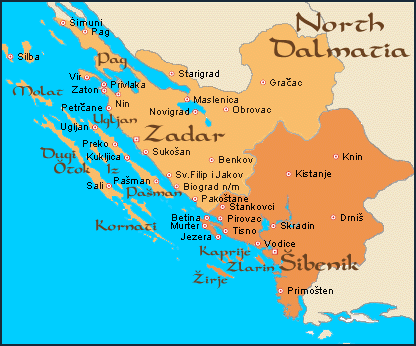
Croatia's Regions

Kvarner
The area consists of three geographic regions - the Croatian Coast (the coast under the Velebit range), the Kvarner bay islands of Krk, Rab, Losinj and Cres and north-eastern coast of Istria, and the hinterland mountainous region of Gorski Kotar. It also includes the north part of the island of Pag. The seat of administration is the city of Rijeka, which owes its architecture to Hungary whilst the islands are heavily influenced by the Venetians.
Set in a privileged position on the north of the Adriatic coast, Kvarner is protected by three mountain ranges: The Velebit chain in the north east, the Gorski Kotar in the north and the Ucka mountain range to the west. Its clement climate has allowed the vegetation to become extremely diverse. With forests of oleander (rose) and chestnut tress growing alongside mandarins, kiwis and lemons. There are four beautiful islands protecting the coast of the Gulf of Kvarner: Krk, Cres, Losinj & Rab. The vegetation on the islands is as diverse; olives and figs grow twisting through the old stone walls, forests of huge pines reach up to the sun and ancient fortified towns melt into little fishing villages. The island of Krk is the most visited of the Kvarner isles because it is accessible via a bridge. Cres, Losinj & Rab have a charm of their own and being less visited give you the chance to find a little deserted beach all to yourself.
Losinj & Cres. A fortune was spent joining these two islands by a bridge but, ironically, in ancient times they were one island - it was the Illyrians who, in 1600 BC, dug out a channel between the two islands for better navigation of their ships. A lot less touristic than other islands in Kvarner they nevertheless merit a visit, not least for their quietness. With the exception of the towns of Cres, Mali Losinj and Veli Losinj the islands handful of towns are very small - mostly less than 100 inhabitants. Although existing in ancient times, the architecture & character of the towns is largely Venetian. Cres and Veli Losinj are pretty little ports and Mali Losinj, in a natural bay, is large enough to take ships.
Rab. The island is quite unlike any other in Croatia. If one looks at it from the mainland, its east side, it doesn't seem to have any vegetation at all, no trees, no shrubs, no grass - nothing! This paints quite an austere picture but actually it is hauntingly magnetic, especially in the evenings when the rays of the setting sun paint the bare rock faces pink. Curiously, the other side of the island, its west side, could not be more fertile; vines, olives, almonds and lemons grow there as well as anywhere on the Croatian coast. The island’s capital is Rab, a lovely mediaeval town with a tremendous number of church towers.
Krk. The island of Krk is the largest island of the Adriatic and the most visited of the Kvarner isles, mainly because it is accessible from the mainland via a bridge. The bridge is at the northern most tip of the island, joining the mainland just south of Kraljevica. The south side of the island is the most touristic. The town of Krk and Baska are the most popular destinations. Conquered and destroyed several times over in antiquity, Krk town owes much of its current architecture to the Venetians who rebuilt it in the 12th century. Like a lot of old Croatian towns the streets are paved with white flagstones which have polished smooth over the years (be especially careful in wet weather - these stones can be very slippy). It has a cathedral, Katedral Uznesenja, built in 1188 over a Roman site where one can still see the Roman baths and basilica. The 16th century castle from the Venetian era is still intact and is used regularly today for open air concerts. The town clock in the town square, Vela Placa, is worthy of mention. it was built in the 16th century and is rare in that it shows 24 hours - midday is at the top, as usual, but midnight is at the bottom!
KVARNER's NATIONAL PARKS:
Plitvice Lakes (Plitvicka Jezera). Situated inland behind the Velebit mountain range, it is the most beautiful and best-known Croatian National Park, and an integral part of the UNESCO World Heritage. It comprises 16 small and large lakes connected by waterfalls created through sedimentation of travertine, a particular type of limestone. The area is covered by thick forests of beech and pine, with a section of it being primeval forest. Animal life is rich with the brown bear being present. Special panoramic tours are organised for visitors both on land and on the largest lakes in panoramic buses and electro-powered boats.
Sjevern Velebits. In the central part of the Velebit mountain range in the most attractive part of this region, around Velebit’s highest peak, it includes the Rozanski and Hajducki Kuk nature reserves. They are comprised of karst rock formations and include the Lukina Jama (Luka Cave) - one of the deepest in the world - and the famous Velebit Botanical Garden.
Risnjak. A forested mountain massif to the north of Rijeka, encompassing the source area of this small area, a haven for an amazing wealth of biological diversity, including brown bear, lynx, chamois, deer, and snake eagle. The beauty of its forests, the karst phenomena and magnificent views attract great numbers of mountaineers.




